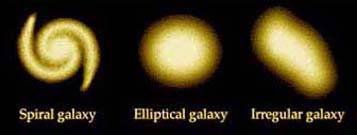Galaxy
What is a Galaxy?

A Galaxy is a large aggregation of stars, gas, and dust, typically containing billions of stars. It is recognised that galaxies are independent star systems outside our galaxy, the Milky Way.
There are three main types of galaxies: spiral, elliptical, and irregular. The Milky Way is an example of a spiral galaxy.
Our galaxy is relatively flat, with most of the material confined to a rather flat disk. The central portion of the galaxy bulges somewhat out of the plane. The parts of our galaxy are the nucleus, the nuclear bulge, the disk (which contains the spiral arms), and a spherical halo.

The diameter of the disk of our Milky Way galaxy is about 120,000 light years. One should keep in mind that there is not really a distinct edge. The halo portion of the galaxy is somewhat larger, with a diameter of about 300,000 light years. The sun is about 30,000 light years from the centre, or in other words roughly half way out along the disk.
The nearest Galaxy to us

The Andromeda Galaxy is the closest large galaxy to the Milky Way and the only one visible to the naked eye in the Northern Hemisphere. It is also known as the Great Nebula in Andromeda. It is 2.2 million light-years away and is part of the local group of several galaxies that includes the Milky Way, which it resembles in shape and composition.
It has a diameter of about 165,000 light-years and contains at least 200 billion stars. Its two brightest companion galaxies are M32 and M110. The light arriving at Earth from the Andromeda Galaxy is shifted toward the blue end of the spectrum, whereas the light from all other cosmic sources exhibits red shift.